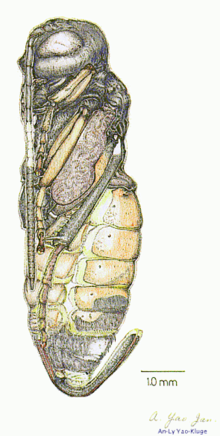Doll (insect)
In zoology, a pupa describes a morphologically clearly demarcated, mostly almost or completely motionless transition stage between the insect larva and the sexually mature full insect (imago) . The pupal stage emerges from the last larval stage after molting and sheds itself into the imago. In any case, this stage is characterized by the fact that no food is consumed.
The pupal stage is characteristic of the holometabolic insects , including butterflies , beetles , two-winged birds , hymenoptera and some other orders. In these, the larvae look completely different from the adult animals ( adults ). Some exopterygota as thrips or scale insects have convergent also developed puppet-like dormant stages, but differ in essential aspects from the real dolls Holometabola.
Movement and agility
While many species have immobile pupae, e.g. B. the swimming pupae of the mosquito genera Culex and Anopheles are very agile. Some dolls make undulating (undulating) movements to aid breathing, e.g. B. with most caddis flies , others have a certain mobility in order to be able to leave hiding places or hulls before hatching to the imago . In some groups the doll has movable mouthparts (mandibles), which mostly serve to cut open a doll's shell. In no case do movable and functional legs appear in the pupal stage. The doll can be hidden in a cavity in the wood or the ground ("doll's cradle") or lie completely free. It is often enclosed in a shell, a cocoon , that was spun by the last larval stage . In some groups, especially the Cyclorrhapha among the two-winged birds and most of the fan- winged birds , pupation takes place within the unstripped last larval skin, which is then referred to as the puparium .
Some groups of holometabolic insects have not just one, but two completely different looking larval stages with different ways of life; usually one of these stages is parasitic. Such a development cycle is called “hypermetamorphosis”. In some cases (e.g. oil beetles ) there is also a resting stage between the first and second larval form, which is then called a "dummy pupa". This sham pupal stage is followed by another larval stage and then the real pupa.
metamorphosis
When the insect larvae pupate, an almost complete physical transformation ( metamorphosis ) takes place. In the pupal stage, the essential imaginal organs such as B. wings, complex eyes, mating organs, of which in the larva usually no externally visible trace, newly created. During the last moult, when the imago hatches out of the pupal skin, these organs only acquire their final shape and harden. Before the last larval stage molts into a pupa, it usually loses its ability to move. Many internal organs become functionless and break down. This stage is often called the “prepupa”. After molting into the pupa, other parts of the body including the skin (epidermis) and the appendages and limbs are often completely dedifferentiated and broken down. Within the dedifferentiated cell mass, however, some sections retain their differentiated shape. From these, the body plan is reorganized so that larval organs can be partially completely broken down and their imaginal counterparts can be formed from scratch. In some two-winged birds in particular, most of the imaginal body emerges from bud-shaped depressions deep inside, the imaginal discs , while the corresponding larval structures disappear completely. However, this radical restructuring is not the rule. In most groups, larval structures are only remodeled without being completely melted down. In some cases cells migrate from the larval organ into the newly forming pupal organ (which corresponds to the later imaginal one). Even in the fruit fly Drosophila , in which the metamorphosis is best studied and which is considered a prime example of a complete and radical remodeling, some cells of the larva are passed on to the imago without any change in function or dedifferentiation. In many groups the pupa has its own pupal organs, which are not present in either the larva or the imago. Examples are the gill threads of the black fly pupa (preformed inside the body of the larva) or the thoracic horns of the mosquito pupae, which are used for breathing.
Doll shapes
Due to the external shape, three different types are distinguished:
- free pupae extremities and wings protruding freely (especially in beetles and hymenoptera)
- Mummy dolls in principle correspond to the free doll, only the body attachments are glued to the body (wasps, butterflies, ladybugs, gnats ...)
- Barrel dolls Doll of the higher flies. The actual pupa corresponding to the free pupa lies hidden in a barrel that is formed from the last larval skin.
Pupa shapes in butterflies
In the case of butterflies (see pupa (butterfly) ), the following types of pupae are also differentiated according to the type of attachment to the base:
- Belt puppets are held in place by a thread looped around their center.
- Falling dolls hang from their rear ends.
The period of metamorphosis and the insect in the process of metamorphosis are also called chrysalis (in ancient Greek χρυσός chrysos 'gold') in the silk moth . In these, the larva spins itself in the last stage of its life as a larva in a cocoon , the threads of which are decoiled and used as silk .
Little fox , about to hatch
Western honey bee drone pupae
"Free pupa" of the Asian longhorn beetle
literature
- Hans Piepho and Alfred Kühn : About hormonal effects in the pupation of butterflies. Göttingen 1936
- Hans Piepho: Investigations on the developmental physiology of the insect metamorphosis . About the doll skinning of the wax moth Galleria mellonella L. Berlin 1942
Web links
Individual evidence
- ↑ Renate Wahrig-Burfeind (Ed.): True. Illustrated dictionary of the German language . ADAC-Verlag, Munich 2004, ISBN 3-577-10051-6 , pp. 159 .








